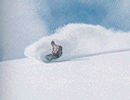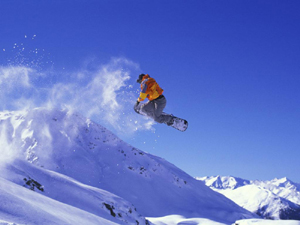|

Riding
Styles
Buying
Gear
Snowboarding
Slang
Weather
Maps
Snow
Resorts
Click
Images To Open






|


 Basic
how to guide and fundamentals of Snowboarding
Basic
how to guide and fundamentals of Snowboarding
Snow
 Snowboarding
/ Skiing Snowboarding
/ Skiing
Riding
Styles
Technical
freestyle
This type
of rider is most often found on the halfpipe or riding in
the snowboard park. Many of today's technical freestyle riders
come to snowboarding with experience as a skateboarder, in-line
skater, BMX, or other action sports background. While the
equipment specific to this type of rider excels in park and
pipe riding, it can also be very versatile across the whole
mountain.
- Technical
freestyle boards
- This
type of board is for in the half-pipe or snowboard park,
and working on your spins and tricks
- Many
technical freestyle snowboards are "signature"
series boards
- Signature
series boards are made to the specifications of a pro
rider
- Usually
found at the highest price points, "signature" series
boards combine cutting-edge graphics with the latest in
hi-tech manufacturing
- Extremely
light board weight is the most common characteristic of
these boards
Freeride
While
an overused term in snowboarding, freeride is still the best
way to describe the majority of snowboarders and soon-to-be
snowboarders. As it suggests, freeride describes a user who
intends to utilize the whole mountain. These riders enjoy
everything about snowboarding: the amazing feel of carving
a turn on freshly groomed slopes, the sense of flight obtained
at lift-off from the big-air jump, the creativity that can
only be understood descending the half-pipe, and the feel
of freedom one gets floating in fresh powder.
- Freeride
boards
- This
board is designed for boarders who want to ride the whole
mountain including the park and pipe
- Freeride
boards can be found at EVERY price point from all snowboard
manufacturers
- Each
board has a unique characteristic which is a derivative
of its: construction technique and materials, shape, flex
pattern, size, and graphics
- For
the most part, there isn't a "bad" board on the market
- Even
the least expensive board produced today can out-perform
the "signature" series boards of just 5 years ago
- This
is the best type of board to learn on and can be used
anywhere on the mountain
Freecarve
This "type"
of riding style is one of the fastest growing segments within
the snowboarding world. Commonly referred to as "cross-over,"
a majority of these riders were once skiers. A freecarve rider
enjoys the full-length and width a mountain has to offer,
continually transitioning from one turn to the next.
- Freecarve
boards
- Freecarve
boards are most often found at the higher price points
- They
are almost always constructed with the same materials
as the technical freeride boards, but configured so that
the board is more suitable for higher speeds and cleaner
carved turns
- Also,
these boards tend to be longer and are usually preferred
for a great day of "freshies"
Alpine/Race
Alpine/Race
riders are easily picked out of the crowd. They are always
seen on groomed trails, laying a trench in the snow with each
turn. These riders "use" a snowboards edge like no other rider.
Using powerful body movements and gravity as their friend,
alpine riders enjoy the sport only when they are connected
to the snow.
- Alpine/Race
boards
- Alpine/Race
boards are long, narrow, stiff, and flashy
- These
boards are made for serious downhill boarders
- Because
they are for riding and carving downhill, they are stiffer
and narrower than other types of boards
- Alpine/Race
boards are not made for doing trick
Rider
Characteristics 
Age
- When
purchasing snowboard equipment, it is important to consider
the rider's age
- If
the rider is still growing, it is to be expected that the
purchase be made with growth considerations in mind
- For
the most part, age is not a determining factor in any snowboard
equipment purchase (board, boots, and bindings)
- The
effect of age is a factor in the final sizing decisions
Weight
- Weight
is by far, the most important rider characteristic in determining
board size
- A snowboard
acts like a leaf spring, in that it has no clue how tall
the person standing on it is, but it does know their weight
- When
a heavy rider purchases a board that is too short, the board
will have a tendency to "wash out" or perform poorly, especially
at higher speeds
- A lighter
person on a longer board will usually have problems controling
their board and initiating turns
Height
- There
is a major misconception in the general public that height
is the single most important factor in determining board
size. As stated above, weight is the most important factor.
- Height
usually comes in to play when the rider's height and weight
are not proportional
- An
unusually tall rider that is relatively skinny may opt for
a longer board. The leverage they gain from the added height
will help offset any loss of control they may encounter.
- The
same holds true for a heavier/shorter rider. They may benefit
from a bit shorter of a board, due to the loss of leverage
from their height.
Foot
size
- Snowboard
boots are sized the same as regular shoes and sneakers,
therefore, your shoe size will be the same as your boot
size
- The
fit of a snowboard boot should be snug and your heel needs
to stay in place when flexed, so if you are between sizes
go for the smaller size
- For
the perfect fitting boot, see Determine Your Shoe Size before
making your purchase decision
Gender
- As
with weight, gender is a critical factor in determining
the appropriate equipment for the rider
- As
a rule, a women's physiology differs from a man's in three
main ways: foot size, center of gravity, and body mass-
all of which effect the way a snowboarder interacts with
their equipment
- Women
almost always have a smaller foot and a lower center of
gravity
- Female
riders of all abilities can find boards and boots specifically
tailored to their physiological differences
- Women's
boards are designed to take into account the riders lower
center of gravity, smaller foot size, and lighter weight
Athletic
ability
- A rider
with extensive experience in other skate/board sports (surfing,
skateboarding, skiing, in-line skating, etc.) will probably
want to invest more in their equipment since they will more
than likely "take" to the sport very quickly
- At
the same time, someone with little outdoor sport experience,
or certain fears that might limit their aggressiveness,
might be best to keep their equipment purchase more conservative
to start
Terrain

Hard
pack and machine made snow
- Hard
pack and machine made snow is usually prevalent among eastern
resorts that are required to make snow since mother nature
can not be depended on to supply natural snow
- Your
snowboarding equipment should contain more vibration control
materials, such as a rubber dampening foil, which will provide
for a smoother ride across hard snow
Groomed
and natural snow
- Groomed
and natural snow can be called powder
or freshies
- This
type of snow is usually prevalent among western and Rocky
Mountain resorts where natural snowfall can be dependable
and deep every year
- Most
riders would benefit from a longer board in a powder snow
conditions. The extra length adds additional lift and helps
the rider float through the snow like a surfer.
Variable
conditions
- Anything
other than powder and hard packed man made snow can fall
into this category
- Most
boards today are designed to excel in variable conditions
- Do
not be tempted to buy a short board if your riding will
take you into various conditions
- A longer
board is almost always preferable, unless you are looking
for a board strictly for technical freestyle riding or are
just learning
Your
riding stance 
- There
are two ways of standing on and riding a snowboard regular
and goofy-foot:
- Regular
riders stand with their left foot forward on the board
- Goofy-foot
riders stand with their right foot forward
- To
determine your style, run and slide across a hard floor.
Whichever foot you put in front is the foot you should have
in front while boarding.
Return
To Top
Your
riding style 
Technical
freestyle
This type
of rider is most often found on the lower elevations of the
mountain, hiking the halfpipe or riding in the snowboard park.
Many of today's technical freestyle riders come to snowboarding
with experience as a skateboarder, in-line skater, BMX, or
other action sports background. While the equipment specific
to this type of rider excels in park and pipe riding, it can
also be very versatile across the whole mountain at less than
full-speed.
- Technical
freestyle bindings
- Technical
freestyle bindings generally use a low hiback with 2 straps
for increased flexibility and range of motion
- These
bindings are not usually value/price driven
- Most
technical freestyle bindings (either step-in or strap)
are made of composite materials in vibrant colors
- Riders
generally gain responsiveness with a minimal weight gain
Freeride
While
an overused term in snowboarding, freeride is still the best
way to describe the majority of snowboarders and soon-to-be
snowboarders. As it suggests, freeride describes a user who
intends to utilize the whole mountain. These riders enjoy
everything about snowboarding: the amazing feel of carving
a turn on freshly groomed slopes, the sense of flight obtained
at lift-off from the big-air jump, the creativity that can
only be understood descending the half-pipe, and the feel
of freedom one gets floating in fresh powder.
- Freeride
bindings
- Freeride
bindings generally have higher hiback with 2 or 3 straps
for added support and control
- These
bindings come in every shape, color, and price
- For
the most part, no matter what the specifics of each freeride
binding, the general effect on the riding experience is
minimal. This holds true for both traditional/strap bindings
and Step-In bindings.
- Binding
choice is commonly a packaging decision or one of brand/price/graphics
Freecarve
This type
of riding style is one of the fastest growing segments within
the snowboarding world. Commonly referred to as "cross-over,"
a majority of these riders were once skiers. A freecarve rider
enjoys the full-length and width a mountain has to offer,
continually transitioning from one turn to the next.
- Freecarve
bindings
- As
with freecarve boots, there are very few freecarve bindings
- Those
that are freecarve specific can usually be distinguished
by their third strap
- Step-In
bindings are also available in a freecarve configuration,
and are almost always manufactured from space-age
composites
Alpine/Race
Alpine/Race
riders are easily picked out of the crowd. They are always
seen on groomed trails, laying a trench in the snow with each
turn. These riders use a snowboards edge like no other rider.
Using powerful body movements and gravity as their friend,
alpine riders enjoy the sport only when they are connected
to the snow.
- Alpine/Race
bindings
- Alpine/Race
bindings are usually a plate binding with hard boots
- Metal
and composites are the only available materials for this
type of binding
Do It with Responsibility & Respect
Snowboarding
California -
Google Maps
View
Larger Map
|
Please Help This Website Click and
Visit Our Sponsor Ads Below. Thank You!
|
|
|
Click Images To Open




Please
Help. Thank
You!
Please
Help. This Website
Visit
Our Sponsors Below
|
